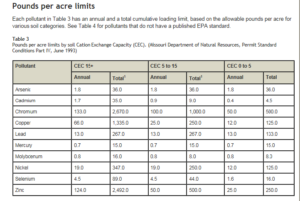What amount of heavy metals am I allowed to apply to my fields?
|
|
This is a question that we sometimes get regarding applications of biosolids. Below is a table from the University of Missouri that was developed referencing EPA guidelines. I think it is helpful information. These levels are for soils with a pH of 6.5 or greater. pH can have an effect on the availability of each individual metal.
Most heavy metals are reported as mg/kg on a laboratory analysis. Mg/kg is basically the same as ppm. So, for example, if your biosolids analysis reported a level of cadmium of 3 mg/kg that would be the same as 3 ppm. You can compute that to being equal to .006 lbs/ton. To reach the annual limit of .9 lb/acre for a soil of CEC 5-15 you could apply up to 15 0 tons per acre. Most likely your application rates would be limited by other factors first, possibly other nutrient levels or economics.
0 tons per acre. Most likely your application rates would be limited by other factors first, possibly other nutrient levels or economics.
The “Total” per acre limits in the table are the cumulative loading limits per acre or the amount that can be applied over a number of years of application.
Levels of heavy metals can be a concern, however, all soils have a certain amount of heavy metals naturally occurring in them. Yet, it is important to know the analysis of any biosolids you are applying so that you don’t misapply any minerals. There are ceiling concentration levels for each heavy metal established by EPA that also limits applications of materials if they exceed these levels, but most biosolid materials fall within these parameters.
If you are a producer that just doesn’t want to risk applying unnecessary heavy metals to your farm then you should choose not to apply biosolids or wastewater products.






